Gallery Portrait
Max Hetzler
Beate Scheder, 2021
Remember Everything. This was the title given by Max Hetzler to the group exhibition celebrating his gallery’s 40th anniversary in late 2013. It was a retrospective of museum proportions, bearing witness to four decades of intensive collaboration with artists and featuring contributions by all those currently represented by the gallery. While it has made a lasting impression, the appeal to remember everything should definitely be further pursued. The Galerie Max Hetzler has made history and continues to do so.
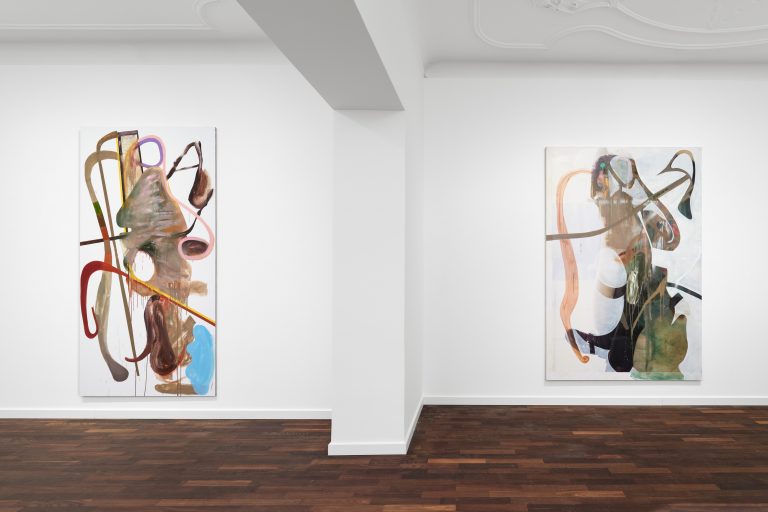
Albert Oehlen, unverständliche braune Bilder, Galerie Max Hetzler, Berlin, April – August 2021. Courtesy of the artist and Galerie Max Hetzler, Berlin | Paris | London © Albert Oehlen. Photo: def image
Only recently, the gallery has opened its new premises on Potsdamer Straße. They are spectacular in terms of their dimensions alone. Originally built as a printing facility for the Tagesspiegel, this location later housed Blain|Southern’s Berlin branch for ten years. The hall is 17 meters high, with gates at the front and back, through which even large sculptures can be easily transported. Up until now, there was no space at Max Hetzler in Berlin for the kind of bronze sculptures that Christopher Wool has been creating for some time. Hetzler is currently present in three locations across the city, including two galleries in Charlottenburg, on Bleibtreustraße—one in an elegant apartment in a historic building, the other in a retail space with large windows in the former home of art dealer Alfred Flechtheim—and one on Goethestraße, in a converted post office branch.
Hetzler opened his first gallery in Stuttgart in 1974. He was 25 at the time. He had just finished an apprenticeship at Kunsthaus Schaller and an internship with Hans Mayer in Düsseldorf, as well as worked briefly at Galerie Rothe in Heidelberg. You could only do something like that if you were very naïve—as the gallery owner puts it today. “You need naivety, enthusiasm, and impudence to open a gallery. And, of course, respect for artists and love for art.”
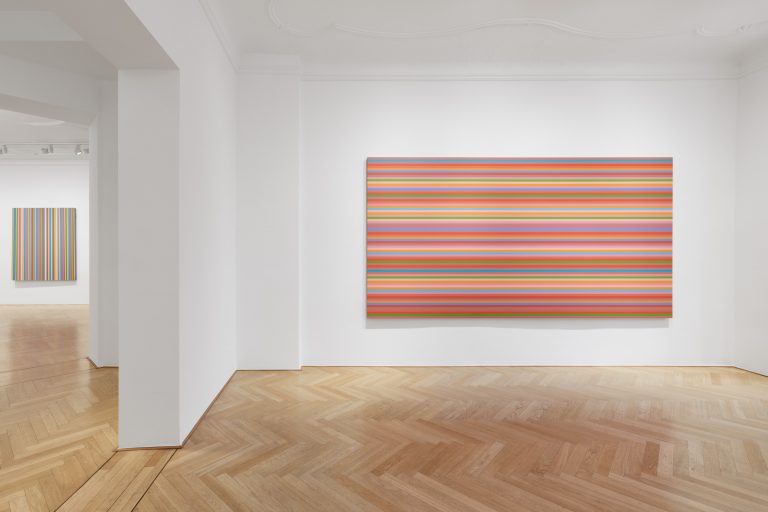
Installation view: Bridget Riley, Galerie Max Hetzler, Berlin, September – October 2020. Courtesy the artist and Galerie Max Hetzler, Berlin | Paris | London © Bridget Riley 2021. All rights reserved. Photo: def image
In 1982, the gallery relocated to Cologne. “Because that’s where you had to be, because that’s where the artists had to be”—artists with whom he had already started working in Stuttgart in the late 1970s. Albert and Markus Oehlen, Werner Büttner, Martin Kippenberger, Reinhard Mucha, and Günther Förg, for example. Extremely successful years for the Rhineland gallery followed. Then, in the late 1980s, the art market collapsed. “Things were at a dead end. It was terrible.” Hetzler wanted a fresh start in a different place. Berlin seemed like an obvious choice. “We hoped that Berlin would become the center for a lot of things—but then it still took 20 years.” As far as art is concerned, Hetzler certainly played his part, not least as the co-founder and driving force behind Berlin’s Gallery Weekend.
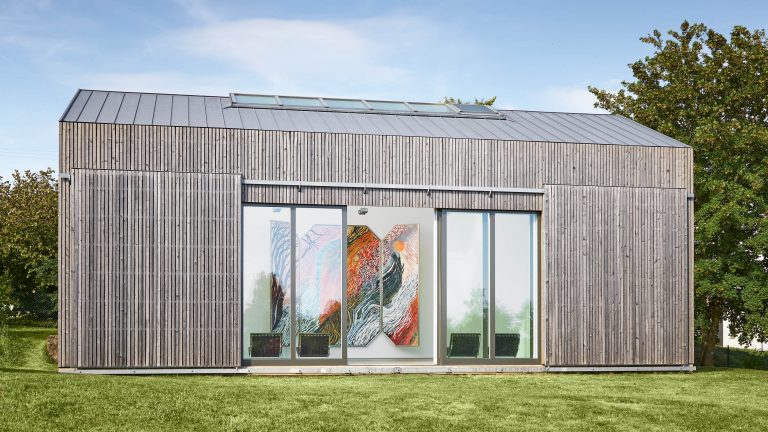
Installation view: Jeremy Demester, Stiftung zur Förderung zeitgenössischer Kunst in Weidingen, Weidingen, 2018. Courtesy the artist and Stiftung zur Förderung zeitgenössischer Kunst in Weidingen, Weidingen © Jeremy Demester. Photo: def image
But before anything else, he had to find gallery spaces again. He recalls that there were plenty of spaces in the east at the time, but the infrastructure was deplorable. Instead, he found what he was looking for in an industrial loft in Charlottenburg. From there, he moved around the city over the next few years: first to Zimmerstraße, and later, after a stopover on Holzmarktstraße, to the imposing former Osram-Höfe in Wedding. It was actually too big for some of his artists—Glenn Brown really didn’t want to exhibit there, so the gallery owner freed up his apartment on Bleibtreustraße for the artist. Furthermore, the rooms posed a number of technical challenges, as Hetzler recalls. There was a freight elevator that kept getting stuck, difficult lighting conditions, water dripping from the ceiling. Artists were happy to work with these obstacles—Albert Oehlen, for example, or Bridget Riley. Mona Hatoum filled the Osram-Höfe with sinisterly enlarged household appliances, Rineke Dijkstra with photographic and video portraits of adolescents, André Butzer with black-and-white N-paintings. Despite such outstanding exhibitions, moving back to Charlottenburg came to the owner as a great relief.
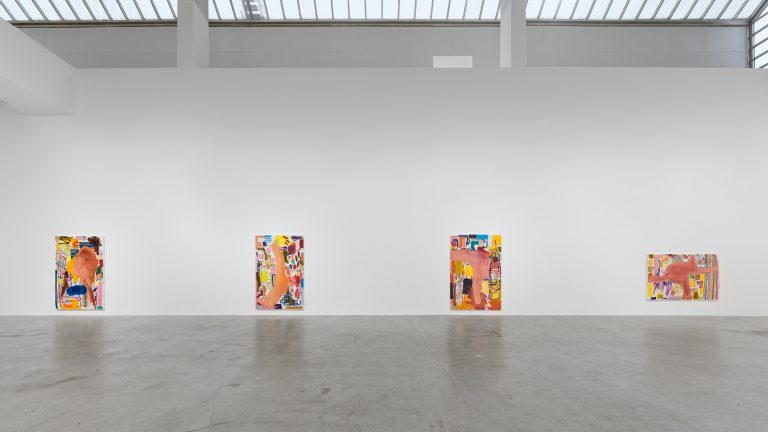
Installation view, André Butzer, Rohe Milch, Galerie Max Hetzler, Berlin, November 2021 – January 2022. Courtesy of the artist and Galerie Max Hetzler, Berlin | Paris | London © André Butzer. Photo: def image
The gallery currently has branches in Paris (since 2014) and London (since 2018). The Paris gallery is run by Hetzler’s wife Samia Saouma, the London one by his son Max Edouard Hetzler. But Berlin is and will remain central, in part because it continues to give Hetzler a space to try things out—unlike London and Paris, where a lot has already been occupied and historically defined, he says. “Berlin remains full of surprises when it comes to exhibitions.”
Since 2012, there is also the Foundation for the Promotion of Contemporary Art in Weidingen, in the Eifel region. It holds an exhibition once a year, offering a residency opportunity. It has also been home to the Günter Förg Library since 2013. Starting in 2022, another gallery location with a similar concept will open in Marfa, Texas.
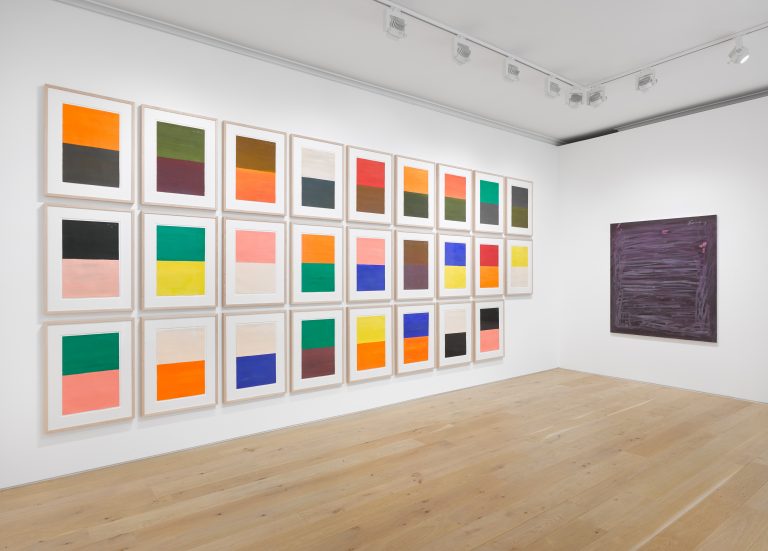
Installation view: Günther Förg, Constellation of Colour, Galerie Max Hetzler, London, November 2020 – Januar 2021. Courtesy the estate and Galerie Max Hetzler, Berlin | Paris | London © Estate Günther Förg, Suisse / VG Bild-Kunst, Bonn 2021. Photo: Jack Hems
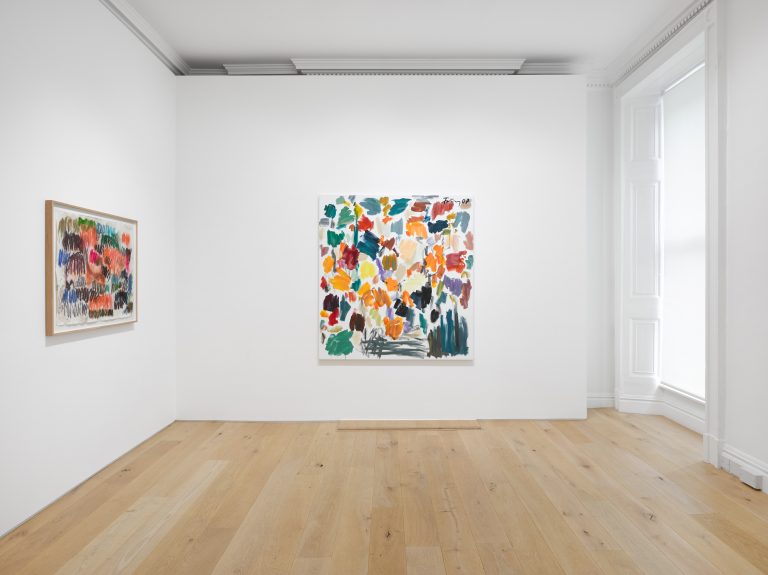
Installation view: Günther Förg, Constellation of Colour, Galerie Max Hetzler, London, November 2020 – Januar 2021. Courtesy the estate and Galerie Max Hetzler, Berlin | Paris | London © Estate Günther Förg, Suisse / VG Bild-Kunst, Bonn 2021. Photo: Jack Hems
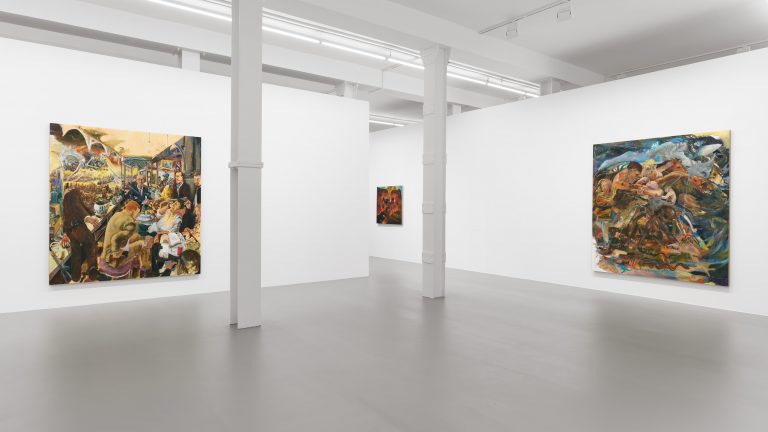
Installation view: Celeste Dupuy-Spencer, But the Clouds Never Hang So Low Before, Galerie Max Hetzler, Berlin, November 2020 – Januar 2021. Courtesy the artist and Galerie Max Hetzler, Berlin | Paris | London © Celeste Dupuy-Spencer. Photo: def image
Max Hetzler is sitting at his desk on the upper floor of the Bleibtreustraße gallery when he tells us about it. It is almost rare to get the chance to meet him there. The conversation takes place at the end of October. He has just returned from the fairs in Basel, London, and Paris, and there will be two openings in Berlin in the following week, including the new Potsdamer Straße space. To kick things off, André Butzer will be showing large-format paintings. A solo exhibition by Ida Ekblad, featuring painting and sculpture, is planned to follow next. The choice of both artists can also be seen as a commitment to the location, “a tribute to Berlin,” as he puts it; both Butzer and Ekblad started their careers in Berlin.
Indeed, artists have always been Hetzler’s top priority. “We try to give everything within our means so that we can make good exhibitions.” And it shows—then as now, here as there.
„Remember Everything“. So nannte Max Hetzler die Gruppenausstellung, mit der er Ende 2013 das 40. Jubiläum seiner Galerie feierte. Eine Überblicksschau musealen Umfangs war das, Zeugnis über vier Jahrzehnte intensiver Zusammenarbeit mit Künstlerinnen und Künstlern, mit Beiträgen aller aus dem aktuellen Programm. Sie prägte sich ein, dem Aufruf, sich an alles zu erinnern, sollte jedoch unbedingt auch darüber hinaus Folge geleistet werden. Die Galerie Max Hetzler hat Geschichte geschrieben und tut das weiterhin.
Gerade erst hat sie neue Räume an der Potsdamer Straße eröffnet. Spektakulär sind diese schon allein wegen ihrer Größe, gebaut ursprünglich, um dort den Tagesspiegel zu drucken, später war dort zehn Jahre lang die Berliner Dependance von Blain | Southern untergebracht. 17 Meter hoch ist die Halle, vorne und hinten mit Toren versehen, durch die auch große Skulpturen problemlos raus- und reingefahren werden können. Für solche, wie sie etwa Christopher Wool seit einiger Zeit aus Bronze anfertigt, war bislang kein Platz bei Max Hetzler in Berlin. Viermal ist Hetzler nun in der Stadt vertreten, außer in Tiergarten mit gleich zwei Galerien in der Bleibtreustraße – eine davon in einer eleganten Altbauwohnung, die andere in einem Ladenlokal mit großen Fensterfronten im ehemaligen Wohnhaus des Kunsthändlers Alfred Flechtheim – und einer in der Goethestraße, in einer umgebauten Postbank-Filiale.
Seine erste Galerie hatte Hetzler 1974 noch in Stuttgart eröffnet. 25 war er damals, hatte gerade mal eine Lehre im Kunsthaus Schaller und ein Praktikum bei Hans Mayer in Düsseldorf hinter sich und kurz bei Galerie Rothe in Heidelberg gearbeitet. Nur machen könne man so etwas, wenn man sehr naiv sei – so erklärt der Galerist es heute. „Man braucht Naivität, Enthusiasmus und Chuzpe um eine Galerie zu eröffnen. Und natürlich Respekt vor Künstlerinnen und Künstlern und Liebe zur Kunst.“
1982 zog die Galerie nach Köln um, „weil man da sein musste, weil da die Künstler sein mussten“, Künstler, mit denen er schon Ende der 1970er Jahre in Stuttgart angefangen hatte zu arbeiten: Albert und Markus Oehlen etwa, Werner Büttner, Martin Kippenberger, Reinhard Mucha oder Günther Förg. Höchst erfolgreiche Jahre folgten für die Galerie im Rheinland. Dann brach Ende der 1980er der Kunstmarkt zusammen. „Gar nichts ging da mehr, es war schrecklich.“ Hetzler wollte einen Neuanfang an einem anderen Ort. Berlin bot sich an. „Wir hatten die Hoffnung, dass Berlin das Zentrum für vieles wird – was dann allerdings 20 Jahre gedauert hat.“ Was die Kunst betrifft, hat Hetzler daran gewiss seinen Anteil – nicht zuletzt auch als Mitgründer und treibende Kraft hinter dem Berliner Gallery Weekend.
Doch zunächst mussten wieder einmal Räume gefunden werden. Im Osten, so erzählt er es, habe es die damals zwar zur Genüge gegeben, aber eine miserable Infrastruktur. Fündig wurde er stattdessen in einer Fabriketage in Charlottenburg. Von dort aus ging es in den kommenden Jahren quer durch die Stadt: erst in die Zimmerstraße, von dort mit Zwischenstopp in der Holzmarktstraße in den Wedding in die imposanten ehemaligen Osram-Höfe. Eigentlich zu groß waren die für manche seiner Künstler – Glenn Brown wollte dort gar nicht erst ausstellen, sodass der Galerist für ihn seine Wohnung in der Bleibtreustraße frei machte. Zudem steckten die Räume voller technischer Herausforderungen, so erzählt es Hetzler im Rückblick: Es gab einen Lastenaufzug, der ständig steckenblieb, schwierige Lichtverhältnisse, Wasser tropfte von der Decke. Die Künstlerinnen und Künstler nahmen sich diesen freilich gerne an, Albert Oehlen etwa oder Bridget Riley. Mona Hatoum füllte die Osram-Höfe mit unheilvoll vergrößerten Haushaltsgeräten, Rineke Dijkstra mit Foto- und Videoporträts Heranwachsender, André Butzer mit schwarz-weißen N-Bildern. Eine große Erleichterung sei es trotz solch herausragender Ausstellungen gewesen, als sie zurück nach Charlottenburg zogen.
Inzwischen unterhält die Galerie Dependancen in Paris (seit 2014) und London (seit 2018). Die Pariser Galerie wird von Hetzlers Frau Samia Saouma, die Londoner von seinem Sohn Max Edouard Hetzler geleitet. Berlin ist und bleibt aber zentral, auch weil es Hetzler weiterhin Raum gibt, Dinge auszuprobieren – im Gegensatz zu London und Paris, wo vieles schon besetzt und historisch definiert sei. „Berlin ist nach wie vor, was Ausstellungen angeht, eine Wundertüte.
Seit 2012 gibt es außerdem die Stiftung zur Förderung Zeitgenössischer Kunst in Weidingen, in der der Eifel. Dort findet einmal im Jahr eine Ausstellung mit der Möglichkeit zu einer Residency statt. Außerdem ist dort seit 2013 die Bibliothek Günter Förg beheimatet. Ab 2022 wird mit ähnlichem Konzept noch einen weiterer Galeriestandort in Marfa/Texas eröffnen.
Max Hetzler sitzt an seinem Schreibtisch im Obergeschoss der Galerie in der Bleibtreustraße, als er davon erzählt, fast schon eine rare Gelegenheit, ihn dort anzutreffen. Das Gespräch findet Ende Oktober statt, gerade ist er von den Messen in Basel, London und Paris zurückgekehrt, in der Woche darauf stehen zwei Eröffnungen in Berlin an, unter anderem die der neuen Räume in der Potsdamer Straße. André Butzer zeigt dort zum Auftakt großformatige Malerei. Als nächstes, für den Februar ist eine Einzelausstellung von Ida Ekblad geplant, mit Malerei und Skulptur. Die Auswahl der beiden ist auch als Bekenntnis zum Standort zu verstehen, so erklärt er es, „eine Hommage an Berlin“, sowohl Butzer als auch Ekblad haben in Berlin ihre Karriere gestartet.
Überhaupt stehen die Künstlerinnen und Künstler bei Hetzler stets an erster Stelle. „Wir versuchen alles zu geben, was im Rahmen unserer Möglichkeiten steht, damit wir gute Ausstellungen machen können.“ Das merkt man ihnen an, damals wie heute, hier wie da.
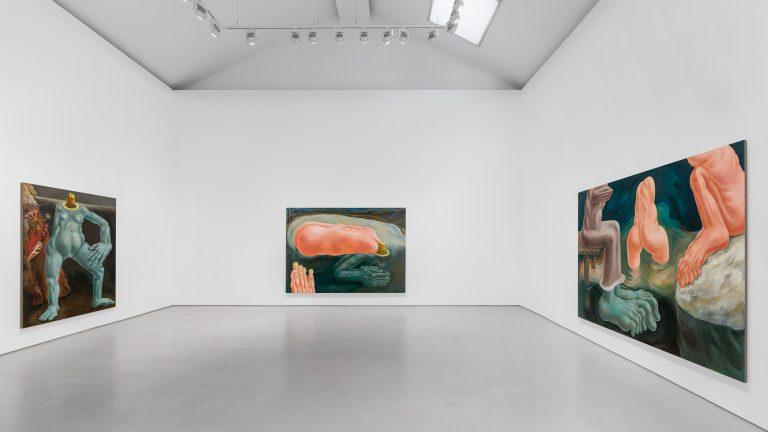
Installation view: Louise Bonnet, Bathers, Galerie Max Hetzler, Paris, September – October 2021. Courtesy the artist and Galerie Max Hetzler, Berlin | Paris | London © Louise Bonnet. Photo: Nicolas Brasseur
